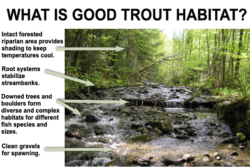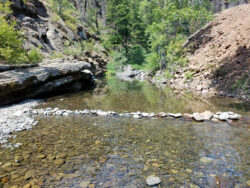Mother Nature Knows Best! When landowners and humans start to manipulate waterflows and established natural ecosystems, things usually go bad for the ecosystem. Many people try to dam up watersheds for personal use. Some want to store water to pump out for irrigation. Others make a deeper pool to swim in. Well-meaning sportsmen try to change or improve a watercourse to make bigger/ better places for fish to live. 
Artsy folks try to make streams an art display by building Cairns. Stacked rocks have been used for centuries to identify trails, stream crossing, and locations. Placing random cairns have no purpose. Taking stones out of a watershed and stacking them is more like vandalizing graffiti than art. If folks want to improve how an area looks, focus on trash removal and keeping natural spaces natural. 
In many states, stream changes are against the law. Montana follows their laws and rules in the Streamside Management Zone publication. Areas between high water marks and around wetlands are protected from manipulation. If a farmer, developer, Forester, landowner, angler, or other citizen wants to change positions of logs, rocks, channels, or other fluvial factors, they need a permit from the state. This means they need a plan design, reason, and an acceptable explanation to change a natural condition. Stream morphology, or the management of stream flows, erosion, and manipulation are best left to the trained scientists.
Huge dams built for hydroelectricity or flood control are also in dispute as to their wants and needs. Many dams are being removed so that fish populations can again migrate to spawn. After years of research, Scientists are discovering better ways to address energy generation and watershed control.
Every rock in a watershed is the home of micro-organisms and insects. When the rocks are moved, the organisms are killed or flushed away. Fish depend upon these insects for food and rocks for shelter. Well-meaning rock movers are destroying habitat, removing food, causing erosion, and negatively impacting the ecosystems.
Changing watersheds means;
Killing organisms, insects
Removing shelter. Exposing critters to predators
Changing stream flows. Creates erosion by accelerating water flows
Blocking fish migration
Slowing stream flow. Warming waters
Redirecting water from natural channels
Years ago, many fishing clubs and agencies encouraged building dams. It was thought that deeper water made better habitat. The problem was that moving rocks only caused more damage. Many of the human made dams were fragile at best. High water wiped them out. More substantial dams only prevented fish from moving up or downstream.
In communities, many proposed construction of cement causeways and culverts. This speeded up flows and when the cement ended, huge erosion ditches would form. Gabions or stone filled baskets were also installed to protect banks and redirect flows.
Any structures created without permitted consent are not allowed. It is best to leave the rocks, logs, and natural flow changes to trained and legal representatives of watershed management.
Take only a picture, leave only a footprint!
Montana Grant